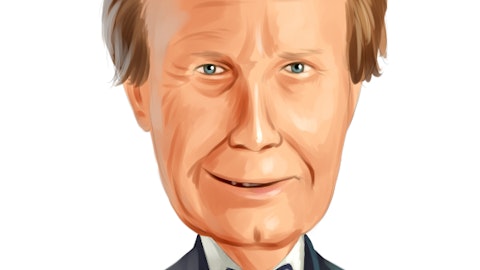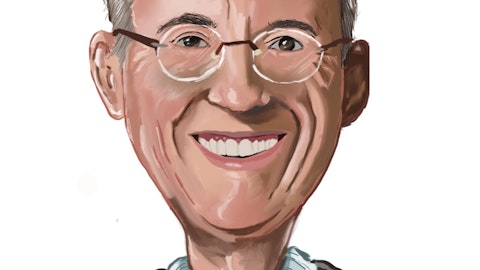Craig Nix: Right now, if you just look at new loan yields that are coming on, our new loans are coming on the books between 5.5% and 6%. The marginal cost of our deposits when you consider the various deposits that we have out there, we’re savings money markets in the 350 range. So spreads 254 , so spreads are around 200 basis points. Tom, do you have anything you’d like to add to that?
Tom Eklund: No. I think that’s accurate. Obviously, rates shift as the market shifts and we pay close attention to both Fed hikes and also sort of how the curve behaves, I suppose.
Craig Nix: But in that dynamic, the inversion of the yield curve remains a challenge.
Tom Eklund: Absolutely.
Stephen Scouten: Yes, definitely. Okay. And maybe just one last thing for me is just on the non-interest-bearing deposit growth. I know you said you think you could grow that mid single digits as well. Anything to note there in particular in terms of customer acquisition plans or otherwise that would lead to that, because I think that’s industry-wide where we’ve been seeing the most pressure especially this quarter, is that maybe negative mix shift away from the non-interest-bearing deposits?
Craig Nix: Yes. I think if you look at just mix of deposits, we are forecasting non-interest-bearing to remain consistent as a percentage of total deposits. And I would just anchor back to our go-to-market strategy, the no loan alone strategy always has emphasized growing non-interest-bearing deposits and we’ve been able to do that through various rate cycles. We will acknowledge that quantitative tightening and potential disintermediation can be headwinds there. But we feel like a 5% growth goal there is achievable and reasonable.
Stephen Scouten: Okay, great. Well, thank you all for all the color. I appreciate it.
Tom Eklund: Thank you.
Operator: . We now turn to Brian Foran from Autonomous. Your line is open.
Brian Foran: Hi. Just going back to the 95 to 100 of EPS and maybe focusing more on the low end of the range, I should be able to do the math. But I mean, is that just because of the nudges on the fee expense and tax rate or is that also because of more uncertainty or higher potential provisions that you’re contemplating?
Craig Nix: Brian, look, just comparing the previous guidance that we gave in the third quarter to the current guidance, we have increased our deposit growth from low to mid single digits to mid single digits growth. We have changed our non-interest income from low single digit growth to flat to low single digit growth. We have increased our non-interest expense guidance from low to mid single to mid single digit growth. So with all that, when you total that up and run it through the model, it just puts us at the lower — it leaves us within that range of 95 to 100 that puts us on the lower end, and it obviously does not incorporate share repurchases in the second half of the year. So I’ll say all that is a lot of moving parts.
Brian Foran: That’s very helpful. And then the Fed cuts you’re incorporating, do those really affect NII at all or do they happen like in December of ’23 in the model, and so they’re not really — I guess do the Fed — the 50 basis points of Fed cuts have been impacted the third and fourth quarter NII?
Elliot Howard: This is Elliot Howard. I would say one of the cuts kind of back in the third quarter, so that has a marginal impact. But the last one is certainly at the very end of the year, so very minimal impact on ’23 for that one.
Brian Foran: Okay. That is it for me. Thank you.
Frank Holding: Thank you.
Operator: Our next question comes from Christopher Marinac from Janney Montgomery Scott. Your line is open.
Christopher Marinac: Thanks. Good morning. I wanted to ask about the deposit beta and kind of the roadmap to 25%. How much of that also spills over into kind of some business account activity beyond what you’re doing with the CIT Bank?
Frank Holding: Sorry, were you referring to business — commercial business or commercial account activity there? I didn’t quite catch the question.
Christopher Marinac: Yes, it was business account activity as well as just the kind of interplay between deposit raising within your online channel, as discussed earlier versus kind of business opportunities within some of your core business accounts?
Frank Holding: Yes. The majority of the beta, as Craig covered sort of the beta categories, where we see the highest beta is obviously in the direct channel. It’s a lower fixed cost channel, but higher variables, higher interest expense there. So that is really sort of the main driver for the overall beta for us.
Craig Nix: Yes, that represents 18% of our deposit beta. If you look at the branch network, we did have a mix of lower beta and moderate beta, that’s 71% of deposits. So those two channels are around 90%. So the branch network really smooth that beta out, lowers it in total.
Tom Eklund: Yes. I’d say overall, we’re experiencing beta similar to historical experience out of the branch network. It’s really sort of the online and those deposit gathering channels that are driving the beta up.
Christopher Marinac: So that 18%, Craig, would that stay constant or would that change over time?




